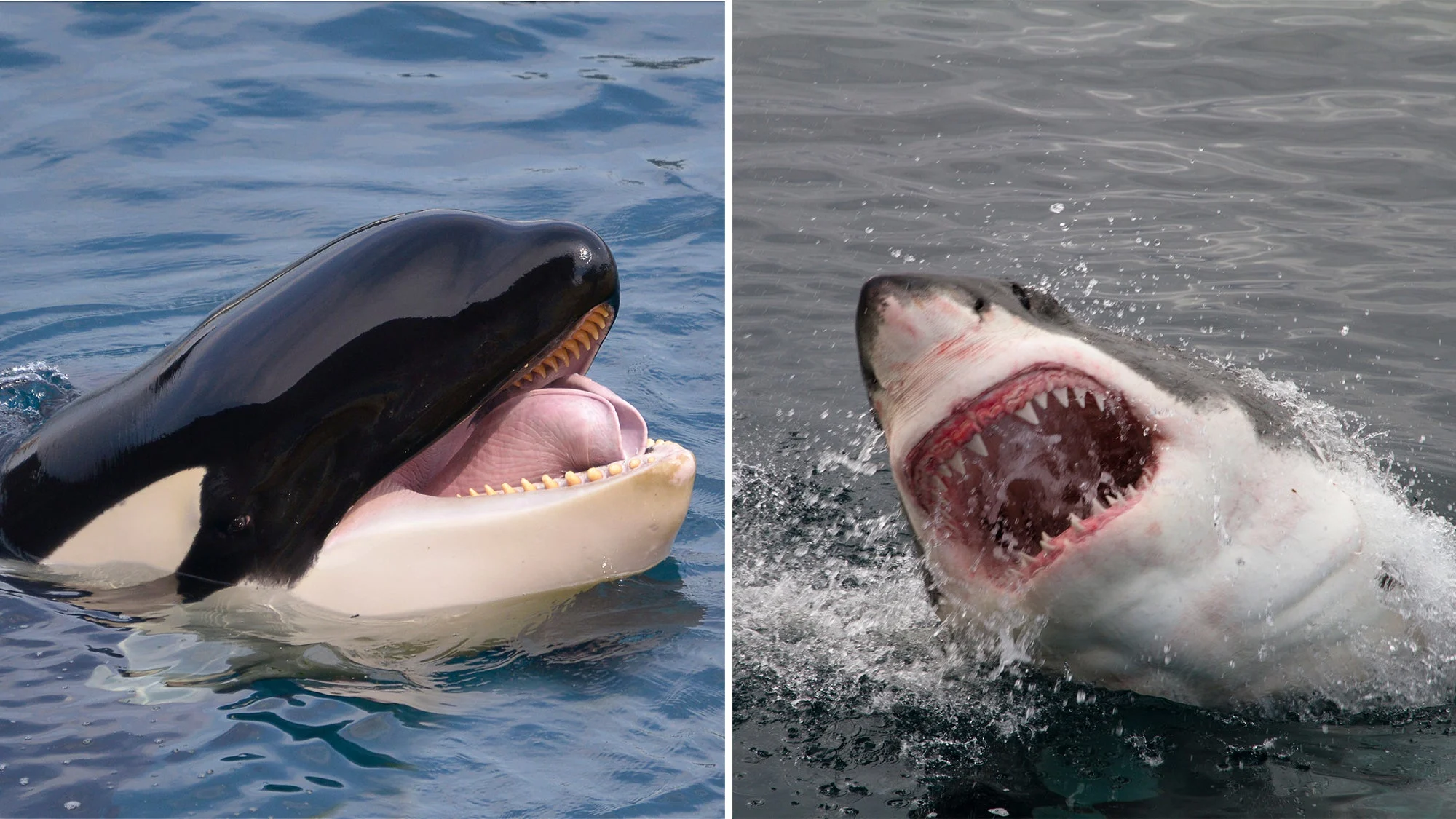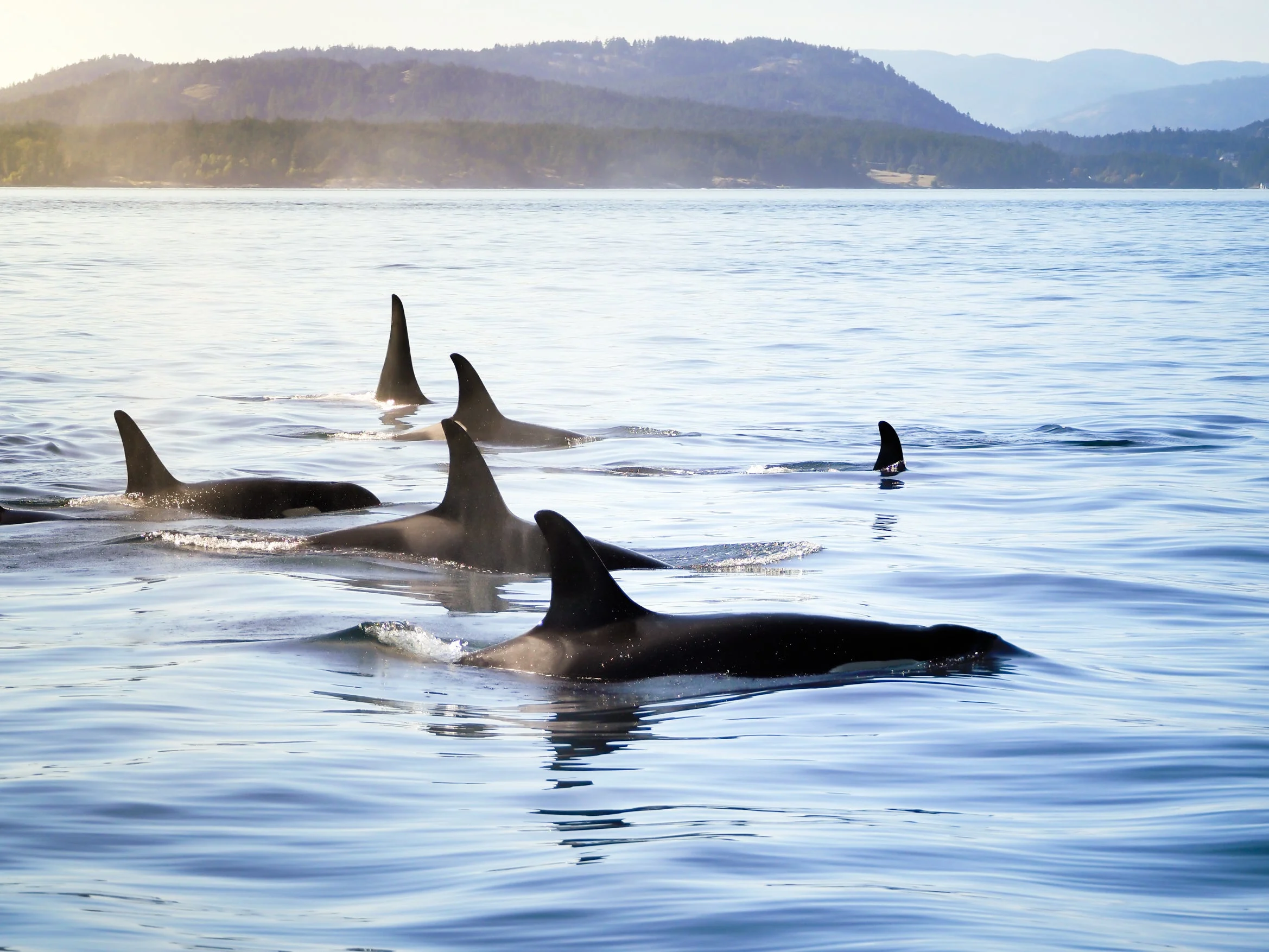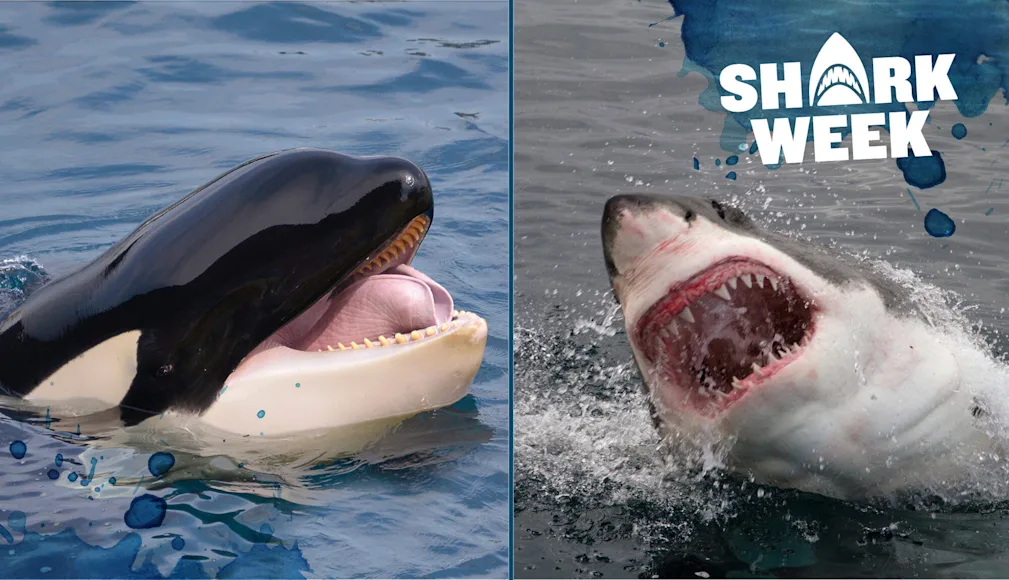In the battle of killer whale vs. shark, one of these two apex predators has a decided advantage, and this holds true even if you narrow it to the fiercest of shark the species, the great white. Although both killer whales and great whites are equipped with a full set of tools for successfully hunting prey and for defending themselves against other predators that might want to make a meal of them, there are a number key differences that set orcas and white sharks apart, starting with body size and hunting strategy. Here’s a complete breakdown—a sort of tale of the tape in the killer whale vs shark showdown.
Who Wins in a Killer Whale vs Shark Battle?
In almost every documented case of killer whale vs. shark, the killer whale wins. There’s no clearer or more graphic example of this than the first-ever video footage of orcas hunting and killing great whites
, captured last year by marine researchers near Mossel Bay, South Africa. Along with the video, scientists released a study reporting that two orcas in the area had h
unted and killed at least 8 great white sharks
over a span of several years. Researchers who examined the carcasses say the killer whales had ripped out the sharks’ livers and then left the remains to drift up on nearby beaches.
Anatomy of an Alpha: Physical Traits of Killer Whale vs Shark

Killer whales are much larger than great white sharks, outweighing them by almost 5 times. Adobe Stock
To understand why killer whales have the upper hand over even great whites, it helps to know how each of these predators is equipped to attack, defend, and evade.
Speed
Killer Whale: An adult killer whale’s top speed in attack mode is 35 mph—plenty fast enough to catch all but the fleetest prey and evenly matched with the great white shark.
Shark: Swimming speed varies by shark species. Shortfin makos, which are among the fastest sharks, can hit 60 mph. A great white’s top speed is closer to 35 mph, though—fast enough to catch a wide range of ocean prey, but not quick enough to escape its much larger nemesis.
Size
Killer Whale: The largest killer whale on record weighed more than 10 tons and stretched 32 feet long. More commonly, an adult male orca weighs between 8,000 and 12,000 pounds and measures 20 to 26 feet long. Females can reach 3,000 to 6,000 pounds and 16 to 23 feet long. Their massive size and ability to hunt in groups allows killer whales to take down some of the largest prey in the ocean, including belugas, narwhals, and even blue whales
.
Shark: The largest great white shark on record is Deep Blue
. Filmed during Shark Week in 2014, the pregnant female measured 20 feet and was estimated to weigh 4,500 pounds. Females average 15 to 16 feet long, though, and they typically grow larger than males (which average 11 to 13 feet). The largest shark ever caught on rod and reel is the IGFA world-record great white, a 2,664-pound monster boated in Australia in 1959.
Bite

The great white has the more ferocious-looking maw, but it doesn’t make up for the orca’s other advantages. Adobe Stock
Killer Whale: Around 40 to 50 interlocking 4-inch conical teeth allow orcas to grasp and kill their prey, then shred it into smaller pieces that are swallowed. They get only one set of teeth for life, so any that are lost are not replaced. Because they can live 50 to 90 years in the wild, older orcas have been known to show extensive wear on their teeth. The jaw strength of a killer whale has never been measured, but some estimates put it at 19,000 pounds of force per square inch (psi), which would rank among the strongest bite forces in the ocean.
Shark: Boasting multiple rows of razor-sharp, triangular teeth, a great white shark can lose more choppers in a day than an orca gets in a lifetime. Sharks are constantly replacing their teeth, carrying up to 300 in their mouths at any time and growing as many as 50,000 over the course of a lifespan. Abundant teeth and strong jaws allow sharks to grasp and kill their prey, and by shaking their heads side to side they use the serrated surface of each tooth like knives to slice flesh into manageable pieces. A 20-foot great white shark can exert 4,000 psi of bite force.
Hunting Methods and Defenses of Orcas vs Great Whites
Not only do orcas enjoy several physical advantages in the battle of killer whale vs. shark, but they also use more sophisticated hunting strategies, which appears to give them an additional edge.
Hunting Methods

One of the key advantages for orcas is that they hunt in packs, whereas sharks are typically solitary hunters. Adobe Stock
Killer Whales: Orca pods use echolocation to find prey, then work cooperatively as a group to apply a variety of learned hunting tactics, much like wolves in a pack. Killer whales have been observed herding fish and mammals into shallow water and even pursuing seals and sea lions onto the beach
. For speedy prey like dolphins, an orca pod will single out one fish and take turns during the chase to exhaust their target. They also work together to create waves to wash seals
off ice floes. When the hunt pits killer whales vs. sharks, some members of an orca pod will distract a great white shark while others move in for the kill. Killer whales are known to target sharks for their nutrient-rich livers, sometimes taking out multiple sharks
over a few hours or days.
Sharks: While research has shown that great white sharks occasionally hunt in pairs, this tactic (which scientists call “eavesdropping”) is rarer and far less involved than the cooperative hunting strategy employed by killer whales. Sharks use their keen senses of smell, hearing, touch, taste, sight, and electromagnetism to locate and identify prey. While they usually strike with great speed to stun and disable their victims, sharks will sometime “test bite” a potential prey if they are uncertain what it is. Scientists believe this phenomenon explains why some shark bites on humans are not fatal and may instead be cases of mistaken identity. While sharks are known to scavenge large fish such as whales, their attacks on live prey usually focus on creatures smaller than themselves.
Defenses
Killer Whales: The massive size, sharp senses, and close-knit social groups that make killer whales such effective hunters also protect them from becoming prey. However, researchers who examined the carcasses of dead orcas concluded that they are susceptible to parasites, diseases, and collisions with ships. The only large marine mammal ever documented to prey on killer whales, it turns out, are other killer whales, which may be attacking and killing members of rival pods.
Sharks: While some shark species are known to camouflage themselves on the sea floor or gulp water and air to make their bodies appear larger, great white sharks don’t have a great arsenal of physical adaptions to defend themselves. Other than a mouthful of sharp teeth and tough hides, great whites rely on their size, strength, and fierceness to deter most predators, and their speed and high maneuverability to swim out of danger. Faced with a predator of equal speed that is also capable of using cooperative hunting tactics, great white sharks are at a decided disadvantage vs. killer whales.
**Read Next: Shark vs Crocodile
**


